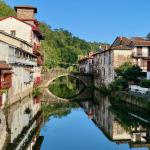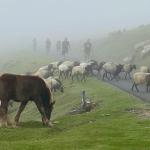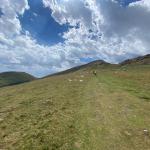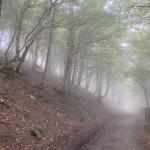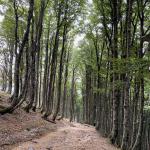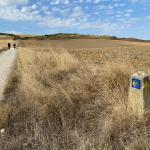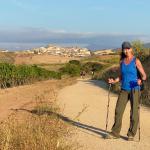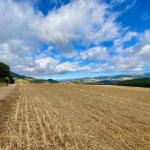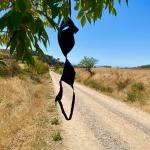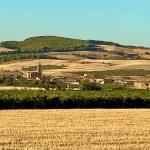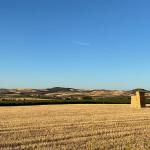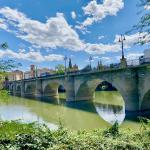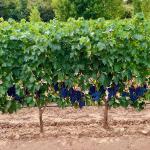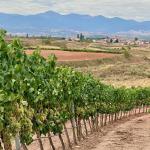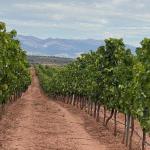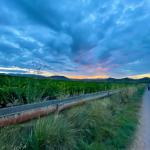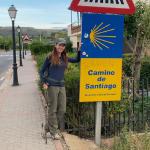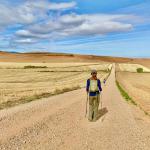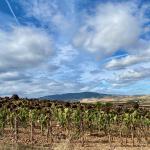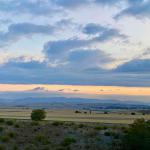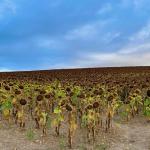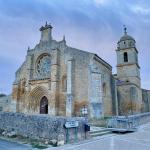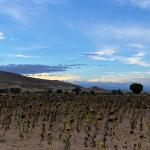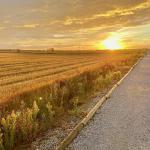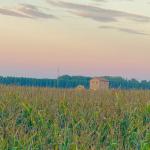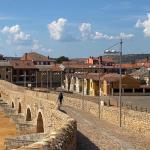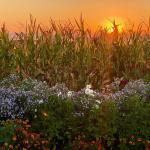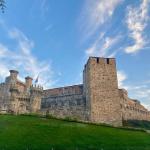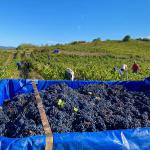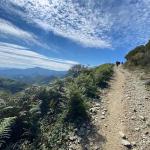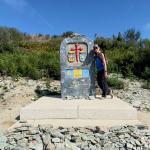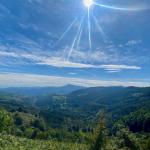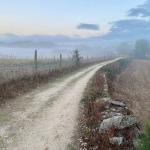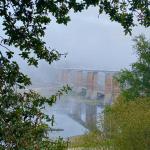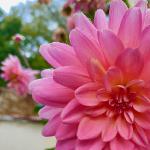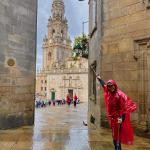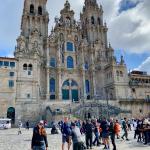© 2011 Sabrina Swenson. All Rights Reserved.
500 mile Camino de Santiago trek
September, 2023
The Camino de Santiago, also known as The Way of St. James, is a pilgrimage of medieval origin. The trek leads to the shrine of the Apostle St. James the Great in the cathedral of Santiago de Compostela in Galicia, northwest Spain. Tradition holds that the remains of the apostle are buried there. After some research I thought, why not! And so my planning began.
When deciding to do the Camino de Santiago, you must first choose which path you will trek. There are many paths that lead to the cathedral in Santiago de Compestella. I chose the traditional Camino de Frances, a 500 mile/800 km trek from Saint-Jean-Pied-de-Port in southern France, over the Pyrenees Mountains and across most of northern Spain. I like to trek, but must admit, 500 miles seemed a bit daunting. I am not a professional trekker. Most people complete the Camino in around five weeks, which includes a couple days off to rest. Often people pick an agency to help with the logistics of the trek. I decided to do it on my own. After decades of solo travel I was confident I’d be able to make it without assistance.
I flew into Biarritz, southern France and shared a taxi to Saint-Jean-Pied-de-Port. The flight from Paris to the south was full of trekkers. Their clothes and backpacks confirmed their intention. Many people I spoke with were staying an extra night in France to rest before the trek, but I wanted to get started. My first stop upon arrival was the pilgrims office in the center of town. This is where you receive your pilgrims "passport". The passport was a pull-out card with spots to be stamped by your accommodation, restaurant, bar or church along the way showing you completed the camino. Once I had that secured, I checked into my guesthouse had dinner and retired. After a good night sleep I began my journey an hour before sunrise. I stepped out into rain and scoffed at having to start the long journey in the wet. As I passed through town and onto the outskirts the rain became harder where it would stay for the first five hours. I started off in my raincoat, but as it was September, it was still quite warm and a bit humid. I switched to my rain poncho. This was worse as it felt like all the heat from my body was trapped in the plastic, which it was. I eventually ripped that off. While trying to fold the gigantic garbage bag-like poncho a nice couple walked by and offered to put it in my backpack so I wouldn't have to take the pack off. These types of small acts of kindness happened daily on the trail. Trekkers looking out for each other. I didn't realize it at the time, but I would run into this American couple over and over on an almost daily basis. It didn't matter how early or late I started or what remote location I was in, I would constantly run into them. Once they had put my poncho in my pack, I continued without any type of protection from the elements as did most everyone else. I was soaked in no time. I simply didn't care.
The first day on the Camino Frances is hands-down the absolute most difficult of the entire trek. Getting over the Pyrenees Mountains is a chore. The elements made an already ridiculously difficult task even worse. Most of the day was spent climbing up and up with no reprieve. Since it was also very foggy you really couldn't see that far ahead of you making the climb seem to never end. The look on everyone elses face showed that they too were struggling. I stopped whenever I felt like it to have a seat on a rock or whatever I could find and have water and snacks. There are only two places on the first day to have something to eat or drink, the guesthouse in Orisson, only five miles into the trek, or the food truck set up by a very opportunistic Frenchman. He simply parked his small van up along the trail, pulled out a table and offered appropriate snacks and drinks for trekkers. You could also, of course, pack your own drinks and snacks, but since you had to bring everything with you on your back, daily, having a heavy pack was something you wanted to avoid.
The first day was not only physically draining, but also psychologically draining. The endless, sideways rain and fog didn't help. The day seemed to go on forever. There was a lot of swearing under my breath in times of frustration and pure exhaustion, but I kept going. Other than the small guesthouse in Orisson, five miles in, there was no other option to spend the night until you crossed the Pyrenees and arrived into Roncesvalles, Spain. As such, quitting simply wasn't an option, unless you wanted to sleep outside without any cover. I must admit the first day was one of the toughest of my life, it took me a whopping ten hours to get to Roncesvalles. I was beyond exhausted and couldn't wait to take a hot shower. I wearily stopped at the first hostel (the normal accommodation on the pilgrimage) and my heart sunk as they told me they were full. Having not made any reservations in advance, I now pondered my decision to not use an agency to assist on my trek! I asked if anyone else had rooms in the small village and they pointed me in the direction of another hostel and a hotel. The thought of having to trek to the next village to look for accommodation was out of the question for me. I had a huge sigh of relief when the hotel I checked announced they had a room. I staggered to my room at sloth speed and collapsed on the bed. I'm not sure how long I was out, but I eventually woke and took the long, hot shower I had dreamed of.
Once in better spirits I decided perhaps it was a good idea to start booking accommodation ahead. From then on I would book at least one, if not two, three or four days in advance. I stayed in a variety of hostels, guesthouses, pensions and a couple hotels. When deciding how far to trek each day, I referenced the book "A Pilgrims Guide to the Camino de Santiago". Apparently I choose the book wisely as of the many books printed about the Camino, almost every trekker had this particular one. I must say, it was a huge help. In it, they lay out daily guides of how far to trek and where to stay. The first week I followed it exactly, being forewarned that most injuries happen in the first week when new trekkers push themselves as they feel they can go farther each day. I stuck to the guide and had no injuries or blisters what-so-ever. The second week, I figured I could go a little further every day, more than the book showed. Pushing myself further was also sometimes required as I couldn't find accommodation where I wanted to stop. A couple times I had to even go slightly off the trek to find a place for the night.
My daily routine was to leave two hours before the sun came up as it was September and Spain is still very hot at that time. The first two weeks were pretty brutal with the blazing sun and heat. The second two weeks due to the area I was in was slightly better. I'd head off in the dark usually without another sole in sight, especially once I decided to go a little further than the guide book showed. I think most of the trekkers stuck to the books itinerary. As such, if I ended up in a different village, I would often see very few trekkers. One particular morning I walked out of my hostel to find thick fog, the kind where it's hard to see your hand in front of your face. People often ask how you find your way on the Camino. There are often signs with yellow arrows pointing the way. Sometimes in the absence of a sign, a yellow arrow is simply painted on a fence, wall, the ground or a rock. As you can imagine, in heavy fog it's very difficult to find your way. My headlamp only shown so far in front of me. Luckily, a couple days before, another trekker told me about Camino Ninja, a great app to have when on the Camino. In case you can't find or see the yellow arrows, you can simply check your app. I noticed a couple days, when apparently day dreaming I missed a turn and ended some way off the trek. Luckily, I was never too far off unlike a small group I ran into that said they went a couple miles off trail before noticing. The trek was tough enough, I didn't need to ADD any more miles. The day I set off in the heavy fog I had to use the app as it was the only option. I quickly started heading up a wooded path with a somewhat precarious drop-off on one side. In the dark, without a bright moon to help me, it was a bit unnerving.
Another early morning after having to stay slightly off the trail due to no accommodation, upon checking the app, I noticed rather than back trekking a way to the trail, I thought I'd follow a small path indicated on the app and cut off the back track. I again set off in the pitch black. I should have checked the altitude as the "shortcut" was a small pathway up a huge hill with trees on each side. Up and up and up it continued in the black sky. I had had enough of climbing after the Pyrenees and was not keen on any more extreme climbs. Eventually I got to the top and started the way down eventually catching up with the trail. It was a bit creepy trekking through the woods in the dark of pre-dawn without a sole around.
My favorite days on the Camino were when I was in the Rioja region. Rioja, well known for some of the best red wines in the world, provided a beautiful background for the trek. There were rolling hills with endless rows of vines. As I walked up and down the modest hills I noticed the grapes were heaving on the vine. Many had already dropped. I'm no wine expert, but wondered why they had not yet started harvesting the grapes, although I know the acidity has to be just right, or the wine will not be what it should.
I walked most days between 4 and 8 hours, the 10 hour first day being the exception. Some days were pretty easy, some not. When I first decided to do the Camino I thought for sure I could knock out lots of miles everyday. When you're doing it everyday, however, it's a lot more daunting that you think. The constant pounding on the body starts to take it's toll, not to mention the psychological drain that creeped in after a couple weeks. The repeating of the same task every day, day after day. I have a short attention span. It was tough.
Most of the Camino trail was picked for it's beauty. There are numerous places were you can take a more direct route, but it would be along a busy highway. As such, the Camino was designed to minimize walking along busy highways not only for safety, but also because it's simply not pleasant walking with vehicles flying by. The most miserable day was on a section that was a shorter day, but due to the rain and walking directly next to a busy highway, with semis splashing by, I couldn't wait to finish. Luckily there weren't a lot of rainy or miserable days. One bright point of starting my day two hours before light, were the many brilliant sunrises I got to witness. The endless sunflower fields were also stunning, although they had already been harvested, it was still a stunning sight due to the shear volume of the fields.
One of my concerns was to make sure I didn't get injured on the Camino, or I most likely wouldn't be able to finish. As I'd have dinner every evening, I inevitably saw endless people in their flip flops with excessively bandaged feet due to multiple blisters. I saw legs up on chairs with ice packs on knees and a variety of other injuries. Some despondent as their injuries proved too great for them to safely continue. I always felt grateful upon seeing these people on an almost nightly basis as I was still well with zero blisters. The main reason I never had blisters was because in addition to my great, broken in Merrell trekking shoes, I also opted for thicker smart wool socks. Not a normal choice for trekking in the searing heat of Spain, however, my thought was, thin socks may be cooler and ok for a short trek, but they'd be no match for a month straight of walking. I was right. Well into the Camino I came up behind an older gentlemen one day who had shorts on. I noticed he had the same kind of wool socks I did. As I passed I asked if he had any blisters, he said no, but I have bad knees and this climbing down is killing me! I would definitely not recommend the Camino for anyone with injuries, bad knees or any other health issues. I would imagine if you did manage to finish, it would be an utmost unpleasant affair.
The only incident I had, was a header I took in the larger city of Lyon. I left my standard two hours before sunrise. In the larger cities, the yellow arrows were not as obvious. As such, I had my trekking poles in one hand and phone in the other referencing the Camino Ninja app. As I crossed a major highway, I didn't notice the slight rise between the two lanes and went flying. My hat, headlamp, phone and poles all flew in different directions. Knowing I was on a major highway, I quickly got up, gathered my belongings and got off the road before any cars came wizzing by. As I realized I was going down, I made my best effort to avoid landing on my knees as I knew that would not be good for a long trek. I somehow managed to land on my palms and luckily only had slight "road rash" on them. I continued and was surprised that I had no aches or pains anywhere, other than my palms. About an hour later I stopped for coffee and a chat with some familiar trekkers and it was only as I got up to leave, did I feel a shooting pain up the side of my femur. Luckily the pain only lasted a day and when I woke the next morning, it was gone. Crisis averted!
All of my clothes for the Camino were picked as they were quick dry. Often laundry services were simply not available so I'd wash my clothes in the sink. They were always dry the next morning with the exception of the heavy socks, which I'd safety pin to the back of my backpack. In the sun, they were dry in no time.
Downtime was spent walking around the new city or village I was in, napping or chatting with other trekkers.
As I neared the last 100 km, the trail swelled with trekkers. Many people, not having the time or desire to do the full Camino, can still get a certificate of completion if they just trek the last 100km. As such, the trail became crowded. It was easy to spot who was new, who wasn’t. Clean clothes, excessive chatting, no limping = new. Bedraggled, dirty and often limping = started at the beginning. Regardless, I made the best of the last stretch and in the end strode into Satiago de Compostella 30 days after I began. Since I was feeling good and with no injuries, I decided to forgo any off days, continued and finished in a month. It was a soggy day when I arrived. I made sure I left extra early on the last day as there was a special service in the cathedral for the pilgrims at 1100. I made my way into the large Roman Catholic cathedral and although I'm not Catholic, nor do I speak Spanish, I enjoyed the service, simply standing and sitting when everyone else did. The highlight was the swinging of the thurible filled with incense, filling the church with fragrant smoke. The smoke of burning incense is considered an oration, with the rising smoke symbolically carrying the people’s prayers to God. This particular thurible is extremely large, weighing over 300 lbs and requiring eight people to properly swing it.
The swinging of the thurible marked the end of my journey. As I went outside the sun had finally broke out and I was able to get better pictures. My last stop was the office in town where I showed my pilgrim’s passport, filled with stamps and receive the certificate of completion. Once in hand, my journey was complete. Adios Camino!

